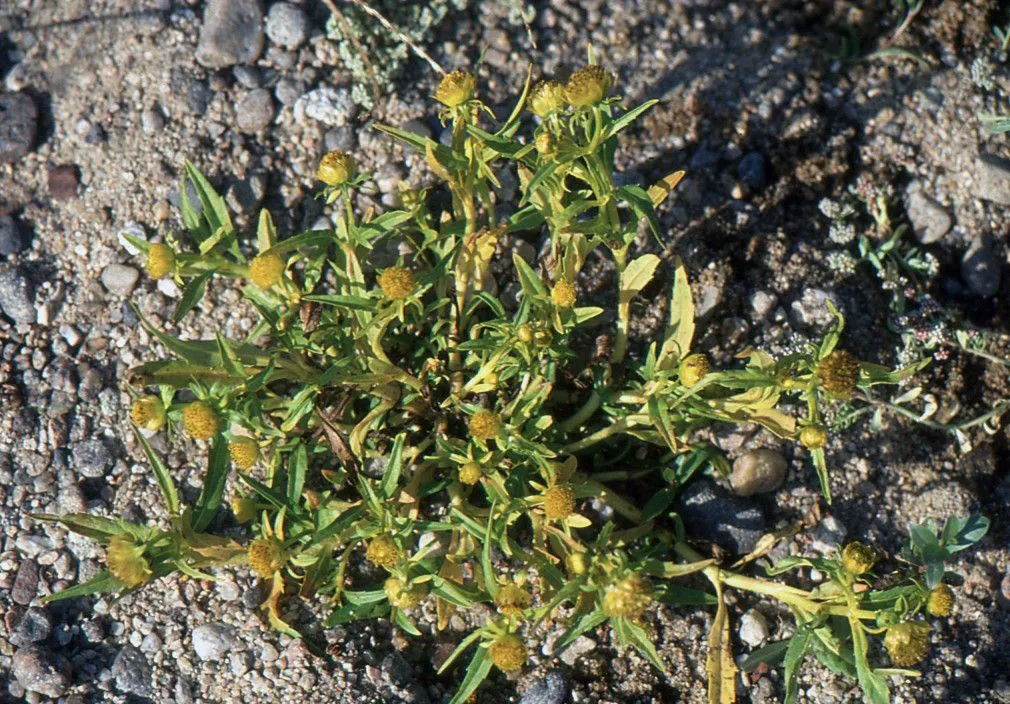
Author: L.
Bibliography: Sp. Pl.: 832 (1753)
Year: 1753
Status: accepted
Rank: species
Genus: Bidens
Vegetable: False
Observations: Subarctic & Temp. Northern Hemisphere
The plant commonly known as Nodding beggar-ticks, scientifically classified as Bidens cernua, is a distinctive member of the Asteraceae family. This perennial herb has garnered attention since its initial documentation in 1753 by the renowned botanist Carl Linnaeus.
Bidens cernua thrives predominantly in the subarctic and temperate regions of the Northern Hemisphere, where it is a familiar sight along the margins of wetlands, streams, and other moist habitats. The plant’s notable “nodding” posture, from which it derives its common name, is characterized by the drooping nature of its flower heads, providing a unique visual cue that distinguishes it from other flora in its environment.
Nodding beggar-ticks can reach heights of up to three feet, and its branching stems are typically angular and hairless. The leaves are lance-shaped with serrated edges, exuding a bright green hue that complements its vibrant yellow flowers. These flowers bloom from mid-summer to early fall, attracting a variety of pollinators, including bees and butterflies.
One of the key characteristics of Bidens cernua is its seed production. The seeds, or achenes, are equipped with small barbs or hooks, aiding in their dispersal by attaching to the fur of animals or the clothing of humans. This effective distribution mechanism ensures that the plant spreads widely and sustainably across suitable habitats.
In addition to its ecological role, Nodding beggar-ticks may have potential applications in traditional medicine and local folklore, although such uses are less documented. The plant’s adaptability and resilience make it a topic of interest for botanists and ecologists studying wetland ecosystems and plant migration patterns.
Overall, Bidens cernua is a plant of considerable ecological importance and distinctive botanical interest, making it a valuable subject for continued observation and study within the diverse and dynamic family of Asteraceae.
Eng: bur marigold, nodding beggar-ticks, nodding beggartick, nodding beggarticks, nodding bur marigold, nodding bur-marigold, nodding burmarigold, nodding burr-marigold, sticktight, nodding beggar’s ticks, nodding burr marigold, pitchfork
Deu: nickender zweizahn
Nor: nikkebrønsle, myrhamp
Dan: nikkende brøndsel
Fra: bident penché, fourchettes
Nld: knikkend tandzaad
Swe: nickskära, nuokkurusokki, gulskära
Nob: nikkebrønsle
Nno: nikkebrønsle
Fin: nuokkurusokki
Cym: graban gogwydd, graban ogwydd
En: Nodding beggar-ticks, Nodding bur-marigold, Nodding beggartick, Nodding Burr-Marigold, Nodding burmarigold, Bur marigold, Nodding beggarticks, Nodding bur marigold, Sticktight, Nodding beggar’s ticks, Nodding burr marigold, Pitchfork
Az: Əyilən yatıqqanqal
Be: Ваўчкі паніклыя
Bg: Наведен бутрак
Zh: 柳叶鬼针草
Cs: Dvouzubec nicí
Da: Nikkende brøndsel
Nl: Knikkend tandzaad
Et: Longus ruse
Fi: Nuokkurusokki
Fr: Bident penché, Fourchettes, Chanvre d’eau penché
De: Nickender Zweizahn, Wasserzweizahn
Hu: Bókoló farkasfog
It: Forbicina intera
Lt: Pelkinis lakišius
No: Nikkebrønsle, Myrhamp
Nb: Nikkebrønsle
Nn: Nikkebrønsle
Pl: Uczep zwisły
Sv: Nickskära, Nuokkurusokki, Gulskära
Zh-tw: 柳葉鬼針草
Cy: Graban gogwydd, Graban Ogwydd
Taken Sep 11, 2020 by John B (cc-by-sa)
Taken Feb 8, 1992 by Tela Botanica − Liliane ROUBAUDI (cc-by-sa)
Taken Sep 13, 2022 by Michał Maciążek (cc-by-sa)
Taken Aug 29, 2021 by Tristan Demone (cc-by-sa)
Taken Sep 9, 2019 by Roozendaal Marc (cc-by-sa)
Taken Aug 29, 2013 by Tela Botanica − Hugues TINGUY (cc-by-sa)
Taken Feb 8, 1992 by Tela Botanica − Liliane ROUBAUDI (cc-by-sa)
Taken Jul 21, 2021 by Patrick Walker (cc-by-sa)
Taken Sep 8, 2018 by Denis SABATIER (cc-by-sa)
Taken Aug 27, 2022 by Gaël Covain (cc-by-sa)
Taken Sep 8, 2017 by Yoan MARTIN (cc-by-sa)
Taken Sep 9, 2017 by Yoan MARTIN (cc-by-sa)
Taken Aug 31, 2022 by Patrick Nard (cc-by-sa)
Taken Sep 9, 2017 by Yoan MARTIN (cc-by-sa)
Taken Sep 9, 2017 by Yoan MARTIN (cc-by-sa)
Taken Sep 7, 2021 by Tasha Tchek (cc-by-sa)
Taken Aug 26, 2021 by Scarlet Rose (cc-by-sa)
Taken Aug 27, 2022 by Gaël Covain (cc-by-sa)
Taken Sep 10, 2022 by Richard Wideman (cc-by-sa)
Taken Sep 8, 2017 by Yoan MARTIN (cc-by-sa)
Taken Aug 8, 2021 by Danielle Mccloy (cc-by-sa)
Taken Sep 18, 2021 by Frozy
Taken Aug 28, 2019 by Daniel SOTTY (cc-by-sa)
Taken Sep 6, 2022 by laura T (cc-by-sa)
Taken Sep 2, 2019 by Natacha Ouellet (cc-by-sa)
Taken Jan 1, 1900 by EOL − Gerrit Davidse (cc-by-nc-sa)
Taken Sep 7, 2021 by Tasha Tchek (cc-by-sa)
Taken Aug 27, 2022 by Gaël Covain (cc-by-sa)
Taken Sep 8, 2017 by Yoan MARTIN (cc-by-sa)
Taken Aug 27, 2021 by Pierre LEON (cc-by-sa)
Taken Sep 15, 2009 by Photoflora – Jean-Luc TASSET (©)
Taken Aug 31, 1866 by Tela Botanica − Herbier PONTARLIER-MARICHAL (cc-by-sa)
Taken Sep 6, 1887 by Tela Botanica − Herbier PONTARLIER-MARICHAL (cc-by-sa)
Taken Sep 8, 2017 by Yoan MARTIN (cc-by-sa)
Taken Sep 8, 2017 by Yoan MARTIN (cc-by-sa)
Taken Aug 15, 2016 by Photoflora – Jean-Luc TASSET (©)
Taken Sep 15, 2005 by Photoflora – Benoit BOCK (©)
Taken Sep 15, 2005 by Photoflora – Benoit BOCK (©)
Taken Sep 18, 2021 by Frozy
Taken Sep 30, 2021 by jane lovett (cc-by-sa)
© copyright of the Board of Trustees of the Royal Botanic Gardens, Kew.
© copyright of the Board of Trustees of the Royal Botanic Gardens, Kew.
© copyright of the Board of Trustees of the Royal Botanic Gardens, Kew.
Growth form: Single Crown
Growth habit: Forb/herb
Growth rate: Rapid
Ph maximum: 7.0
Ph minimum: 5.1
Light: 8
Atmospheric humidity: 7
Soil nutriments: 8
Family: Myrtaceae Author: (F.Muell.) K.D.Hill & L.A.S.Johnson Bibliography: Telopea 6: 402 (1995) Year: 1995 Status:…
Family: Rubiaceae Author: Pierre ex A.Froehner Bibliography: Notizbl. Bot. Gart. Berlin-Dahlem 1: 237 (1897) Year:…
Family: Sapindaceae Author: Koidz. Bibliography: J. Coll. Sci. Imp. Univ. Tokyo 32(1): 38 (1911) Year:…
Family: Asteraceae Author: A.Gray Bibliography: Pacif. Railr. Rep.: 107 (1857) Year: 1857 Status: accepted Rank:…
Family: Fabaceae Author: Medik. Bibliography: Vorles. Churpfälz. Phys.-Ökon. Ges. 2: 398 (1787) Year: 1787 Status:…
Family: Aspleniaceae Author: (Cav.) Alston Bibliography: Bull. Misc. Inform. Kew 1932: 309 (1932) Year: 1932…